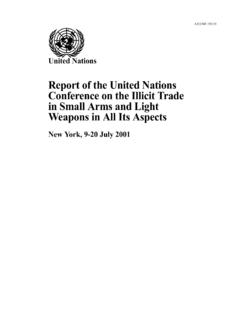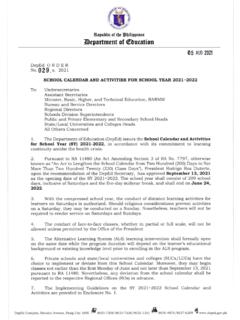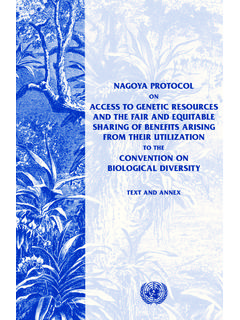Transcription of 100 Years of Drug Control - United Nations Office on Drugs ...
1 A CENTURYOF INTERNATIONALDRUG CONTROL100 YEARS19091912 1914 1919/20 1920 1925 1931 1936 1946 1948 1953 196119711972 AcknowledgementsThe present report is an extended version of Chapter 2 of the World Drug Report was produced in the Policy Analysis and Research Branch under the supervision of Sandeep Chawla, by the Statistics and Survey Section (headed by Angela Me) and the Studies and Threat Analysis Section (headed by Thibault le Pichon). Core Team: Thomas Pietschmann (research and writing); Melissa Tullis (editorial assistance and writing); Theodore Leggett (editorial assistance and writing); Suzanne Kunnen, Kristina Kuttnig, and Nancy Cao (design, layout and desktop publishing). The printing of this report was supported by a financial contribution of the European Commission in connection with the ten-year UNGASS publication has not been formally of ContentsDrug Control 1909-2009: A Positive Balance Sheet - Preface by the Executive Director 3 Explanatory Notes 5 Executive Summary 7 Introduction 13 The Drug Situation Prior to the Establishment of an International Drug Control System 15 The Emergence of an International Drug Control Consensus 29 The Development of the Legal Framework and Codification of the International Control System 33 International Drug Control under the Auspices of the United Nations 59 Drug Trends over a Century of Drug Control 81 Achievements and unintended Consequences of the International Drug Control System 893trol conventions were adopted under the auspices of the United Nations (in 1961, 1971 and 1988).
2 Adherence is now almost universal. illicit drug use (mostly on an occasional basis) has been contained to around 5 percent of the adult population or of the world s total population a much lower preva-lence than less regulated Drugs like alcohol and tobacco. Deaths due to Drugs are limited to perhaps 200,000 a year which is one tenth of those killed by alcohol and twenty times less than those killed by tobacco. It makes no sense to unravel this achievement, that has been a century in the making, by loosening controls on drug use. Yet this progress can only be maintained by coming to terms with the unintended consequences of drug Control , espe-cially the massive criminal black market in drug trafficking. It is therefore essential to reduce the vulnerability of people to Drugs (through health and social services for prevention and treatment), the vulnerability of farmers (through devel-opment), and the vulnerability of societies to Drugs and crime (by promoting economic growth and the rule of law, and by fighting crime and corruption).
3 The drug Control centenary provides a golden opportunity to reflect on lessons learned and to ensure that drug Control in the 21st century is fit for Maria Costa Executive Director United Nations Office on Drugs and CrimeDrug Control 1909-2009: A Positive Balance Sheet For those who doubt the effectiveness of drug Control , con-sider this. In 1906, 25 million people were using opium in the world ( of the world population) compared with opiate users today ( of the world population). In 1906/07, the world produced around 41,000 tons of opium five times the global level of illicit opium production in 2008. While opium used to be produced in a huge belt, stretching from China to Indochina, Burma, India, Persia, Turkey and the Balkan countries, the illegal production of opium is now concentrated in Afghanistan (92%). Same for coca. Its leaves used to be cultivated not only in the Andean region but also in several Asian countries includ-ing Java (Indonesia), Formosa (Taiwan) and Ceylon (Sri Lanka).
4 Today coca leaf production is concentrated in three Andean countries: Colombia, Peru and Bolivia. International drug Control can take some of the credit. As this report points out, the first steps were taken grudg-ingly. Despite a major opium epidemic in China at the end of the 19th century, there was little interest in suppressing a business that was so profitable for opium merchants, ship-pers, bankers, insurance agencies and governments. Many national economies were as dependent on opium as the addicts themselves. Indeed, what Karl Marx described as the free trade in poison was such an important source of revenue for Great Powers that they fought for Control of opium markets. But by the beginning of the 20th century, the global trade in Drugs was becoming a global problem which required a global solution. With the prodding of anti-opium activists, the first international conference on narcotic Drugs was held in Shanghai in 1909, paving the way for the International Opium Convention of the Hague in 1912.
5 Over the next fifty Years , a multilateral system to Control production, traf-ficking and abuse of Drugs was developed. Three drug con-5 Explanatory NotesThe present report is an extended version of Chapter 2 of the World Drug Report designations employed and the presentation of the material in this publication do not imply the expression of any opinion whatsoever on the part of the Secretariat of the United Nations concerning the legal status of any country, territory, city or area or of its authorities, or concerning the delimitation of its frontiers or boundaries. Countries and areas are referred to by the names that were in official use at the time the relevant data were publication has not been formally edited. Maps: The boundaries and names shown and the designa-tions used on maps do not imply official endorsement or acceptance by the United names: This text covers a long historical period, during which many place names have changed.
6 UNODC has made every effort to apply place names consistently and to associ-ate them with the proper time period or current names. These attributions and equivalencies do not have official endorsement or acceptance by the United Nations . The following abbreviations have been used in this report:ARQ annual reports questionnaireATS amphetamine-type stimulantsBRQ Biennial Reports QuestionnaireCICP Centre for International Crime PreventionCMO Comprehensive Multidisciplinary outline for Future ActivitiesCND Commission on Narcotic DrugsDND Division on Narcotic DrugsDSB Drug Supervisory BodyECOSOC Economic and Social CouncilFATF Financial Action Task ForceGovt. GovernmentICMP UNODC Global illicit Crop Monitoring Programme IDU Injecting drug useINCB International Narcotics Control BoardLSD lysergic acid diethylamideMDA methylenedioxyamphetamineMDMA 3,4-Methylendioxy-N-methylampheta- min, known as Ecstasy OAC Opium Advisory CommitteePCOB Permanent Central Opium BoardPCP phencyclidineTHC tetrahydrocannabinolUNFDAC United Nations Fund for Drug Abuse ControlUNGASS United Nations General Assembly pecial Session, 1998 UNODC United Nations Office on Drugs and CrimeWHO World Health Organization Weights and measurements u.
7 Unit lt. Litre kg Kilogram ha Hectare mt Metric ton7 Executive SummaryNearly 100 Years ago, the international community met in Shanghai to discuss the single largest drug problem the world has ever known: the Chinese opium epidemic. Prior to the 1909 Shanghai Opium Commission, national gov-ernments and state-sponsored monopolies played an active role in peddling opium across borders. The profits to be made were enormous, generating as much as half of the national revenues of some island states serving as redistribu-tion centres. Even a country the size of British India derived 14% of state income from its opium monopoly in 1880. At the peak of the opium trade, tens of millions of Chinese were addicted to the drug, and nearly a quarter of the adult male population used it annually.
8 The massive opium imports which supplied consumers caused the country s formerly massive foreign reserves to dwindle. China had unsuccessfully fought two wars against the British Empire to stop opium importation. When forced at gunpoint to legal-ise the drug, China too began to cultivate. This brought currency outflows to a halt and created a huge source of tax revenue. At the time of the Shanghai Commission, China derived at least 14% of its income from the trade s enormous revenues ensured that there were important political and economic interests vested in con-tinuing the trade. Given this, the success of anti-opium trade campaigners in using multilateralism to confront the damage caused by the opium trade is remarkable. The Shanghai Commission represents one of the first truly inter-national efforts to confront a global problem. But the dec-laration of the Shanghai Commission was a non-binding document, negotiated by delegates lacking the power to commit on behalf of their states.
9 Creating and enacting the international law and normative instruments presently avail-able to deal with the global drug problem would be done via numerous agreements and declarations issued, and would take roughly one hundred of the Drug Control System The first international drug convention, the International Opium Convention of The Hague, was signed in 1912 and entered into force in 1915. The peace treaty of Versailles contained a clause which required all its signatories to adhere to the provisions of the International Opium Convention of The Hague. The International Opium Convention of The Hague, designed to curb shipments of narcotic Drugs that were not meant to be used for medical purposes, thus emerged as a truly international instrument. As of 1920, international drug Control became part of the tasks assumed by the League of Nations . Under its auspices, three main conventions were developed (1925 Convention, 1931 Convention and 1936 Convention).
10 These provided the groundwork for the practical operations of the interna-tional drug Control system, and, indeed, much progress was made in curtailing the licit trade in narcotic Drugs during this period. Following World War II, multilateral drug Control came under the auspices of the United Nations . A number of protocols to improve the Control system were established and signed in the post-war Years , the most far reaching of which was the 1953 Opium Protocol. The next milestones - (i) the Single Convention on Narcotic Drugs , 1961 (which was subsequently amended by a Proto-A CENTURY OF INTERNATIONAL DRUG CONTROL8col in 1972), (ii) the Convention on Psychotropic Sub-stances, 1971, and (iii) the 1988 United Nations Convention against illicit Traffic in Narcotic Drugs and Psychotropic Substances - each responded to specific new or unresolved developments, and, added new elements to the Control regime.















